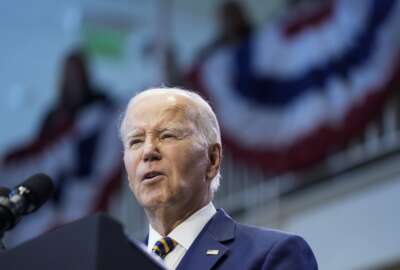VA launches AI Tech Sprint to reduce burnout among health care employees
The Department of Veterans Affairs is looking at artificial intelligence tools to accelerate its work reducing burnout among its health care workforce.
The Department of Veterans Affairs is looking at artificial intelligence tools to accelerate its work reducing burnout among its health care workforce.
The VA, through an AI Tech Sprint it launched Tuesday on Challenge.gov, is calling on technologists to develop tools that will allow clinicians to spend less time with paperwork, and more time treating patients.
The department is specifically looking at AI dictation tools that will help clinicians take notes during medical appointments, as well as AI tools that can help analyze and summarize patients’ medical records.
Tech teams have until Jan. 5, 2024, to participate in the AI Tech Sprint. The VA will award a total of $1 million to winning teams.
Gil Alterovitz, the director of VA’s National Artificial Intelligence Institute, said the VA is looking at how it can use AI to make sure its clinicians have access to a veteran’s full medical history, even if that veteran has received care outside the VA medical system.
“We want to make sure that when they come back to the VA system, they’re able to make use of that information,” Alterovitz said. “And right now, that information may arrive as faxes, may arrive as images in a way that is not ready for easy searches and easy analysis by the provider.”
Under Secretary for Health Shereef Elnahal said in a statement that solutions from the AI Tech Sprint will reduce burnout among clinicians and improve veteran health care.
“AI solutions can help us reduce the time that clinicians spend on non-clinical work, which will get our teams doing more of what they love most: caring for Veterans,” Elnahal said.
The VA is launching the AI Tech Sprint as part of the executive order President Joe Biden signed Monday, calling for a “governmentwide AI talent surge” across the federal workforce to build up its capacity to lead on this emerging technology.
The AI Tech Sprint is expected to further the work of the Reduce Employee Burnout and Optimize Organizational Thriving (REBOOT) Task Force that the Veterans Health Administration launched last year.
The task force is developing tools to address clinician burnout, based on feedback from frontline VA health care workers.
VA Secretary Denis McDonough recently told reporters he credited the work of the REBOOT task force with helping VHA exceed its FY 2023 hiring goals and reduce turnover to levels not seen since the start of the COVID-19 pandemic.
Top members of the REBOOT task force see AI tools as an opportunity to further reduce burnout.
Kavitha Reddy, the associate director of employee whole health in VHA’s Office of Patient-Centered Care and Cultural Transformation, said in an interview that paperwork is a “real burden” for health care providers, and that AI has the potential to ease that burden.
“We’re all looking forward to understanding how that might be able to decrease how much time we’re spending in front of a computer, and thereby allowing us more time to sit and talk with veterans and learn more about them,” Reddy said.
Jessica Bonjorni, VHA’s chief of human capital management, said the REBOOT task force is coming up with ways to reduce retention and burnout, based on what the agency is hearing from frontline employees.
“We know that a lot of things in the HR space tend to impact employee burnout,” Bonjorni said. “One of the key things [is] making sure we have enough staff to handle the workload.”
VHA more than doubled its workforce growth targets for FY 2023. It also saw a 20% decrease in the turnover rate among VHA employees, compared to the previous year.
“The numbers are really, really encouraging to see the growth,” Reddy said. “Once somebody is hired in, the important piece is what are we doing to retain them and keep them here.”
The REBOOT task force is developing solutions based on what it hears from about 30 chief well-being officers stationed across VA health care facilities.
“Their goal is to look specifically at what are the drivers of burnout in their day-to-day work,” Reddy said.
Chief well-being officers listen to frontline employees, then sort through that feedback with facility management and come up with ways to put these ideas and suggestions into practice.
“They absolutely are developing relationships across their facility, trying to learn not just from the service chiefs, but the frontline employees themselves. What are those ‘pebbles in your shoes?’ What are those things that are getting in the way of you having fulfillment in the work that you do every day?” Reddy said.
VHA, based on employee feedback, is offering more flexible work schedules to VA clinicians, particularly nurses.
Bonjorni said VHA is allowing some registered nurses to work a “72 for 80” schedule. Under this system, nurses work three 12-hour shifts each week – for a total of 72 hours per two-week pay period.
Nurses working this schedule are paid the same as if they worked a more traditional eight-hour shift five days a week.
Bonjorni said this new way of scheduling reflects some of the best practices in private health care organizations.
“That really tends to, from the feedback we’ve gotten from our employees, improve their experience of burnout, because they have more time to spend with their families,” Bonjorni said.
Bonjorni said VA facilities implementing these new schedules are seeing a reduction in turnover, which contributes to overall cost savings.
Reddy said the REBOOT task force is promoting flexible scheduling, as more employers explore alternatives to the traditional five-day workweek.
“Often there are some myths about whether somebody can be productive, or meet the needs of their colleagues or patients that they’re taking care of. And what we’ve seen, coming through the pandemic, is that people can, in fact, be very productive with flexible schedules,” she said.
The REBOOT task force, based on feedback from frontline VA health care workers, is also streamlining mandatory training.
“When you work in the federal government for a long time, there’s some training that you have to take every single year. And what we’re looking for is to make sure that we are offering options for evaluating the knowledge that people already have, so that they can go ahead and perhaps take a test and confirm each year that they understand the fundamentals of that required training. And then they wouldn’t need to sit through an hour-long training to reinforce that same information,” Bonjorni said.
Copyright © 2025 Federal News Network. All rights reserved. This website is not intended for users located within the European Economic Area.
Jory Heckman is a reporter at Federal News Network covering U.S. Postal Service, IRS, big data and technology issues.
Follow @jheckmanWFED






